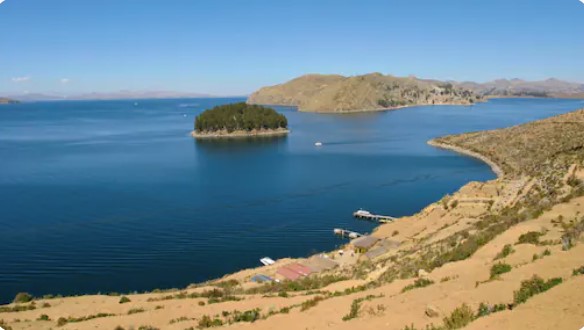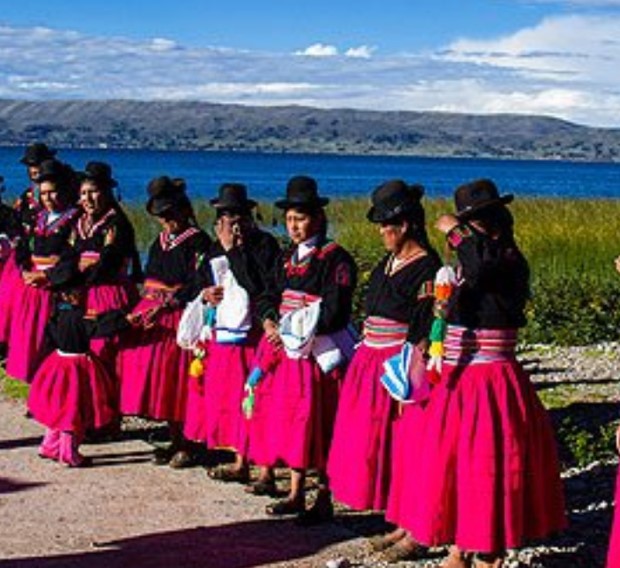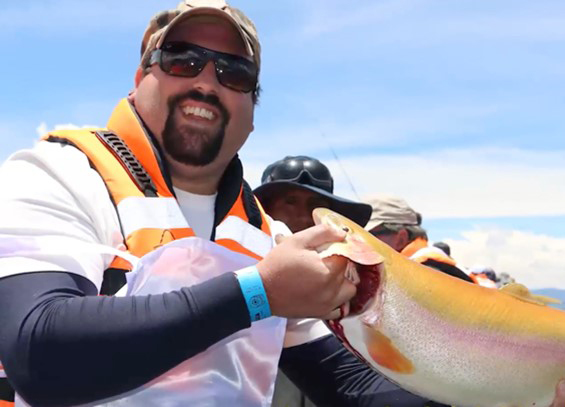Go to ESP
PERU
What is the color blue for us? How do we relate to it? That color, which accompanies all our children's drawings when we represented the sea or the sky, but with which no fruit or vegetable is identified. We drew blue grapes and eggplants even though we knew that was not their color.
Our relationship with the color blue has been a little bumpy throughout history. Neither the Chinese nor the Greeks nor the Arabs nor the Icelanders or the Hindus include the word blue in their ancient stories. The sky is pink and the sea is red in the Iliad and the Odyssey. This is explained by linguists when they mention that primitive languages describe the world first in terms of black and white, then they include red, because of blood, then come green and yellow and at the end, as if you don't want the thing, comes blue.
In fact, the color blue is also absent in the beginnings of art. It was only in the Middle Ages that the color ultramarine blue was created from lapis lazuli, so called because it was brought from Afghanistan, and it was the most expensive pigment at that time, even more so than gold. In ancient Peru, lapis lazuli was known since long before the Incas, and the latter included blue in their main ceremonies to paint huacas and dress the Inca and his priests.

Blue is said larama in Aymara, the native language of the altiplano, which includes northern Chile, part of Bolivia and Puno in Peru. We do not know if ancient Aymara knew the word larama, but it is hard to imagine, especially if they ever went to Luquina Chico. There, under a clear sky, Lake Titicaca is at its best. In that place, with the look lost in the horizon, it is impossible not to think of a single word: blue.
Welcome to Go Latin American Podcast, exclusive program of Go Latin American Travel, I am Jose Lahura.
Thank you very much for listening to us. This is our first program and what we want is to do something slightly different from other travel podcasts, since what we really want is to share with you more than a tourist attraction, an experience. After this pandemic the world will never be the same again and many things will change and others we will have to change, including tourism. Gone will be that aggressive and predatory tourism that promotes the destruction of natural and historical landscapes, that takes us from one side to another without being able to breathe, that does not allow us to have a connection with people, a real experience.
So that's what we are here for, every week we are going to share a new experience in Latin America, and this week we start with Luquina Chico and Luis Asencio.

Luis Ascencio lives in Luquina Chico. He is a widower, father of nine children of which seven are women. Since always, in this town on the shores of Lake Titicaca, the main economic activity has been agriculture, bean fields, olluco, potato, barley, oats, and of course, quinoa. Heh. Perhaps there is nothing more beautiful than a quinoa field when it is in bloom. Plants that range from five to ten feet tall, with branches that go up to the sky in the form of clusters of vivid and different colors... red, green, yellow, purple, nature shows us that we still have intact our capacity to surprise us.
There are also sheep, mainly, with which the villagers prepare their wools of different thicknesses and thus weave all kinds of textiles, skirts, ponchos, coats, scarves, gloves, tablecloths, even linen and embroidery, work that is shared by both men and women. In Luquina Chico the tasks are equally distributed regardless of gender, whether in the kitchen, in the field or on the loom.
But without the need to delve into the economic and social issues of the rural world in the Latin American Andes, the truth is that life in Luquina Chico was very difficult. Meanwhile, the islands of the Uros and Taquile were filled with hundreds of tourists every day. But let's be honest, without resources or training it was very difficult for them to open their doors to tourists and have them visit them.

While Luquina Chico has an impressive view because it is located on a peninsula in Lake Titicaca, other nearby towns had archaeological remains put in value, developed infrastructure and contacts with tour operators that guaranteed a constant flow of tourists.

The only way to attract visitors was if they organized themselves as a community and together took on the task of reinventing themselves without losing an ounce of their essence. Luis, as a judge of the community, together with his son Richard and other residents decided to join forces and develop Community-based Rural Tourism in Luquina Chico. Thanks to the guidance of the Ministry of Foreign Trade and Tourism and other government agencies, they gradually cleaned up the community and its surroundings, fixing and standardizing the buildings,
improving the kitchens, building guest rooms, designing the restaurant. All this was accompanied by a deep training that included quality in the service of tourist attention, care in the selection and preparation of food, creation of products of interest to visitors.
The latter is very important. For those who arrive in Luquina Chico, not only a majestic view of Lake Titicaca awaits them, but also 32 families ready to attend to them in a surprising way. On the one hand there are the somewhat
traditional services such as those involving activities related to the lake itself. There you can practice artisan fishing, especially fishing for golden trout, which for reasons of sustainability requires that the visitor buy the fish he gets, which will be cooked later in the restaurant and that avoids the indiscriminate depredation of the fauna. Likewise, there are activities in sailing boats, rowing boats and kayaks that will take you to the tip of the Chucuito peninsula, where the lake becomes endless, framed by the distant Bolivian snow-capped mountains on the other shore.

There are also some archeological remains near Luquina Chico, especially chullpas, which are funeral towers built by the Aymara lords who populated the area around the lake and which extended to the north of Chile and Argentina in the period between the Tiahuanaco and Inca cultures, that is to say between the years 1200 and 1400 approximately. Note that this does not mean that the Aymara language necessarily comes from the lake area, especially because the language of the Tiahuanaco was completely different, so there are theories that say that the language comes either from the central area of Peru or that it originated in northern Chile. Either way the language was established along with this kind of small kingdoms scattered all over this area and they were not in very good relations with each other. The famous chullpas of Sillustani is the sample of these mausoleums in the form of perpendicular towers made mainly of stone fitted perfectly and without the need of any type of mortar or something that sticks them one to the other.
But the chullpas of Luquina Chico are from another lordship, a little less showy, that have not been put in value by the state and that obviously have been looted many, many years ago, like most of the archaeological remains, either during the time of the conquest or in the Republican era, because despite the interest in preserving the cultural heritage since the independence of Peru, the enormous number of archaeological sites to protect, added to the process almost always late to incorporate them into the list of protected areas, left these places free to lurk for thieves, the onslaught of time and the laziness of the inhabitants.
But let's go back to Luquina Chico, to Luis Ascencio and to the reason for this program, because non-traditional tourist activities have to do precisely with the traditions of this community. Each family that provides rural community tourism services receives the tourists at the town's dock, since the way to get there is normally by the lake. There, Luis, with some of his children, welcomes and accompanies visitors to his house. There you will find rooms with bathroom included, where the beds are made of adobe in order to keep warm at night, and an impossible number of quilts and blankets to make sure that the cold is not a concern for the tourists. Logically, all of these quilts have been woven by the residents of the community themselves.
Once installed, you can take a walk in the surrounding areas, climb up to the natural viewpoints overlooking the lake, always accompanied by a member of the Ascencio family. Back at the house, everything works like clockwork: while Luis or his son Richard tell about the history of the town, the business of rural community tourism and answer all the questions that are asked, some daughters prepare lunch, others bring the ingredients, others prepare the table, while the little ones play.
Soon it is indispensable not to feel in some way at fault for not participating also in domestic chores, which indeed happens. From choosing the potatoes harvested in the family garden, to accompanying the sheep to pasture, the visitor has the opportunity to experience what it means to live in Luquina Chico. Of course, at an altitude of 4,000 meters it is not so easy to carry out these tasks, so it is not so demanding for the tourist either. However, it is still an interesting experience, especially if they have never done it before, getting their hands dirty to work the land or participate in the maintenance and repairs of the community. Of course, more than one traveler has mentioned that his help was almost non-existent due to his lack of experience, but the idea of these activities does not necessarily lie in helping the community, but in making the visitors participate in the existence of a different world, a space in which they can venture and integrate, it is an approach to the other, not so much as a tourist attraction but as a human being. It is called experiential tourism because somehow the experience lived in this place changes the tourist forever.
The food is simple but very nutritious. Based on potato and quinoa, it also includes other vegetables such as goose, beans, olluco, typical Andean ingredients. Also included are the trout caught earlier. Additionally, medicinal plants and herbs that are abundant in the area, such as eucalyptus, dandelion, muña, verbena, can be collected to treat stomach, bronchial, liver or nerve ailments. Even don Luis reads the coca leaves.

But at the end of all the activities, after the walks and the kayak trip, after sharing the domestic, family and traditional tasks, there is nothing left but to lie down in one of the hammocks installed in front of the Lake. There, the microclimate created by the Titicaca makes it almost never cold during the day. It is something unique to be in one of those hammocks, with the fields in the middle, its animals and in the background the lake, huge, imposing, unforgettable... blue.
Go Latin America Podcast is written and produced by me with the support of Janine Soenens and Narowé Lahura. For this chapter we thank Nelly Calderon of Balsas Tours and Richard Ascencio. For now, Luquina Chico is languishing because tourism has been completely suspended due to the Covid-19, they have resumed their agricultural practices waiting for the beginning of a new normality. Remember that Luquina Chico is an ideal destination prepared to receive tourists once the restrictions are lifted, especially because of its open spaces and rigorous updated sanitary protocols. If you want more information about Luquina Chico, travel plans, costs and sanitary protocols, contact your Go Assistant and plan your trip in a personalized way. We are a production of Go Latin American Club, your trip starts when you imagine it. For more information go to golatinamericaclub.com or download the app available for Android and Apple. Join the club, your next adventure we will live together.